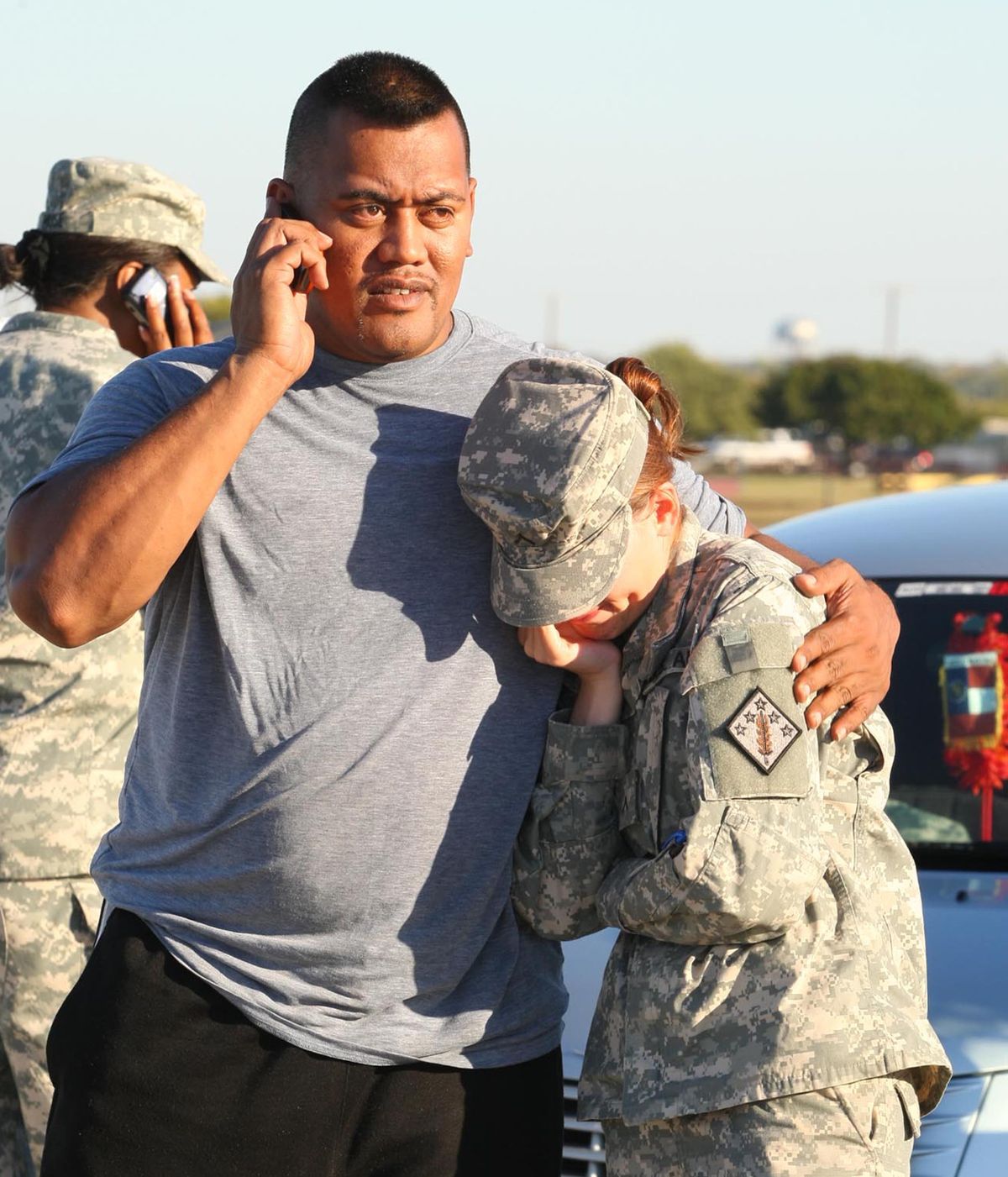The gunfire: Attack lasted just minutes but killed 12
The suspect: Shot four times, man is in custody

The gunshots came out of the blue.
An Army psychiatrist, trained to treat soldiers under stress, allegedly opened fire Thursday in a crowded medical building at Fort Hood, Texas. When the assault ended minutes later, the attack had become what is believed to be the largest mass shooting ever to occur on a U.S. military base. Twelve were killed, 31 wounded.
Nidal Malik Hasan, a major who had made a career in the military, fired a pair of pistols, one of them semi-automatic, dropping and scattering people as they waited to see doctors, according to authorities. Hasan and a civilian policewoman exchanged fire, they said. Both were hit. Both survived. But Hasan, shot four times, was on a ventilator and unconscious, according to military officials.
When the gunfire stopped, soldiers schooled in battlefield medicine ripped their clothes to make tourniquets and bandages. Someone hustled to seal off an auditorium in the same building where 138 troops were marking their graduation from college. Sirens typically used to warn of tornadoes sweeping across the plains alerted residents, schools locked down and the Fort Hood community struggled to understand what had just happened.
In the aftermath, a string of unanswered questions remained about the suspect’s motives, his background and whether the military was aware that he posed a risk to his colleagues.
The accused gunman, initially reported killed but later revealed to be in custody in a hospital, is a Virginia-born doctor who once practiced at Walter Reed Army Medical Center. The Associated Press, citing an unnamed official, reported that Hasan had received a poor performance evaluation at Walter Reed.
The motive remains unclear, although some sources reported the suspect is opposed to U.S. involvement in Afghanistan and Iraq and was upset about an imminent deployment.
The attack erupted shortly after lunchtime on the sprawling complex that has absorbed more than 500 fatalities in Iraq and Afghanistan, more than any other base. Investigators said their initial impression was that the gunman had acted alone.
The victims were taken to various hospitals, where local residents were lining up to donate blood.
“It’s a terrible tragedy. It’s stunning,” Army Lt. Gen. Robert Cone told reporters gathered outside the facility northeast of Austin.
“Soldiers and family members and many of the great civilians who work here are absolutely devastated.”
Hasan, 39, graduated from Virginia Tech in 1997 and earned a doctorate in psychiatry from the Uniformed Services University of the Health Sciences in Bethesda, Md. He spent at least six years at Walter Reed before moving to Fort Hood.
He had been a “very devout” worshipper at the Muslim Community Center in Silver Spring, Md., attending prayers at least once a day, often in his Army fatigues, said Faizul Khan, a former imam there.
“To know something like this happened, I don’t know what got into his mind,” Khan said.
“There was nothing extremist in his questions. He never showed any frustration. … He never showed any remorse or wish for vengeance on anybody.”
A co-worker identified as Col. Terry Lee told Fox News that Hasan opposed the U.S. role in Iraq and Afghanistan and told others that “we should not be in the war in the first place.”
He said Hasan acknowledged that soldiers have a duty to follow the commander in chief’s orders, but was hoping that President Barack Obama would order a pullout from the conflicts.
“When things weren’t going that way,” Lee said, “he became more agitated, more frustrated with the conflicts over there.”
Obama promised to “get answers to every single question about this horrible incident.” He offered his prayers to the wounded and the families of those killed, calling them “men and women who have made the selfless and courageous decision to risk – and at times give – their lives to protect the rest of us.”
“It’s difficult enough when we lose these brave Americans in battles overseas,” Obama said. “It is horrifying that they should come under fire at an Army base on American soil.”
Thousands of soldiers have passed through the gates of Fort Hood on their way to Iraq and Afghanistan, and more than 500 have not come home. Post-combat stress has been an acknowledged problem on the base, and this year alone, 10 Fort Hood soldiers have committed suicide.
Lt. Gen. Rick Lynch, the former base commander, won praise for trying to reduce stress. Adm. Mike Mullen, chairman of the Joint Chiefs of Staff, told the Army Times that “there’s something going on at Hood that I think is extraordinary that we need to emulate until we find something better.”
The Council on American-Islamic Relations moved quickly to call the attack “cowardly.” The organization, an advocacy group for American Muslims, said it condemned the shooting “in the strongest terms possible.”
“No political or religious ideology could ever excuse such wanton and indiscriminate violence,” CAIR said in a statement. “The attack was particularly heinous in that it targeted the all-volunteer army that protects our nation.”
The Fort Hood shooting follows a June incident outside a Little Rock military recruiting center in which one soldier was killed and another wounded. Authorities said Abdulhakim Mujahid Muhammad, who converted to Islam and changed his name as an adult, acted alone in the incident. He has pleaded not guilty.
Muhammad had traveled to Yemen before the shooting, where he emerged on the radar of a Joint Terrorism Task Force.
Local police said that he was motivated in part by political and religious fervor.
The shooting at Fort Hood came 18 years after a massacre in a restaurant in nearby Killeen, where George Hennard used a pair of 9 mm pistols to kill 22 people and wound 17 more before using his last bullet on himself.
At the time, it was the deadliest mass shooting in the country, eclipsed in 2007 when 32 people were shot and killed at Virginia Tech.